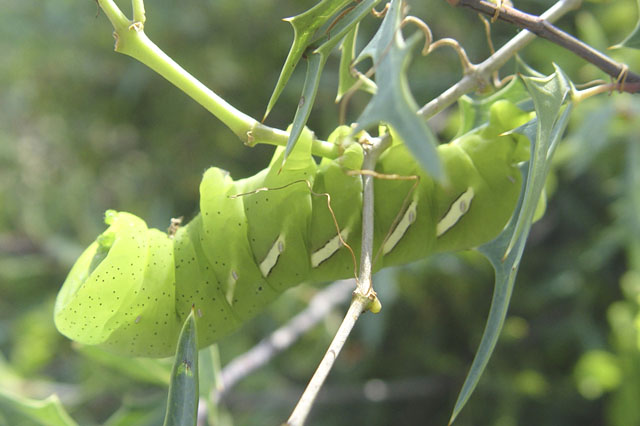
Eumorpha vitis, Austin, Texas, September 19, 2005, courtesy of Melody Lytle.

Eumorpha vitis, Austin, Texas, September 19, 2005, courtesy of Melody Lytle.
This page is inspired by and dedicated to
Mike Quinn who sent me many images of Sphingidae larvae from Texas.
Mike suggested a thumbnail pictoral checklist for larvae, so here it
is!
Many thanks also to Melody Lytle who has sent me many
outstanding images of Sphingidae larvae. Melody has also
sent me many images of trees/shrubs/vines/flowers from her area in
Travis County. They are posted to
Melody Lytle Host Plant Index
For care of "found larvae/caterpillars" visit Manduca sexta August 21, 2008, Trina Woodall.
Seventy-five Sphingidae species are listed for Texas on the U.S.G.S. website. Not all of the species are reported or anticipated in the central region. It is hoped that this checklist, with the thumbnails and notes, will help you quickly identify the moths you are likely to encounter.
A "USGS" indicates the moth is reported on the USGS website and/or in Lepidoptera of North America, #1. Distribution of Silkmoths (Saturniidae) and Hawkmoths (Sphingidae) of Eastern North America, an excellent little booklet available through Paul Opler.
Please help me develop this list with improved, documented accuracy by sending sightings (species, date, location), preferably with an electronic image, via email to Bill Oehlke.
Many thanks to Valerie Bugh who provides this beautiful image of a fourth instar Erinnyis lassauxii larva.
E. lassauxii seems to be rather more common in Austin than usual this year. Dan Hardy saw an adult in mid-Aug. and Barbara Ribble had an adult at her home on Aug. 20. We saw another adult on Aug. 30 at the LBJ Wildflower Center. Someone sent a photo of a mature caterpillar from north Austin on July 24 (feeding on oxypetalum). The attached photo is from Sept. 1 at Zilker Preserve, where there were several caterpillars feeding on very wilted talayote. This is the same location where I found a mature caterpillar in late Nov. 2009 (which eclosed in mid-Dec.). Barbara is raising one of the caterpillars and it already molted and lost its tail."
Many thanks to Sarah D. Grubb who sends the following image and commentary:
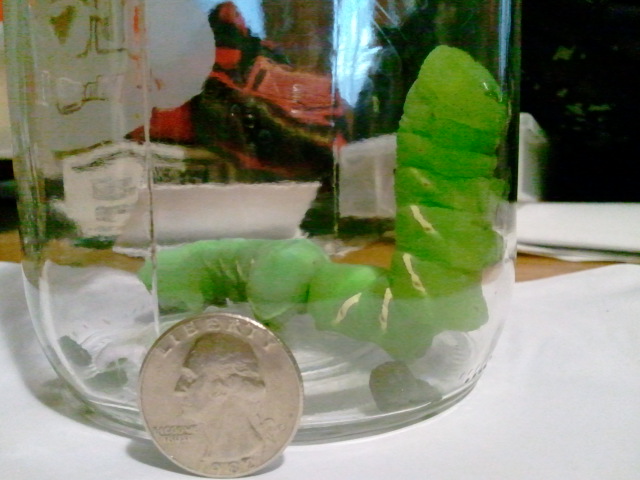
Eumorpha vitis, 12 miles east of Austin, TX.,
October 7, 2013, courtesy of Sarah D. Grubb
"Enclosed is a pic of the two that I found. One is lighter than the other slightly, and their excrement looks like wet withered, decomposing leaves in small, wet, loose pellets.. did not know if you knew that."
I reply, " Thanks for image and commentary. The wet stool might indicate they are clearing their guts in preparation for underground pupation." Please also send your sightings to BAMONA, an excellent on-line resource which has replaced USGS.
Visit Central Texas Sphingidae: Adult Moths
Visit Texas Catocala: Underwing Moths
Sphinginae subfamily
Manduca rustica Georgetown (Williamson), Texas, September 13, 2007, Martha Stroud-Merry.
Smerinthini Tribe:
Macroglossinae subfamilyDilophonotini tribe:
See Hemaris comparison to help distinguish the next two species.
Hemaris diffinis, Georgetown, Williamson County, October 18, 2002, Jill Burrows.
Philampelini tribe:
Eumorpha vitis, Austin, Texas, September 19, 2005, courtesy of Melody Lytle. Eumorpha vitis, Converse, Bexar County, November 2008, Lisa Tingle. Eumorpha vitis, 12 miles east of Austin, TX., October 7, 2013, Sarah D. Grubb
Macroglossini tribe:
Xylophanes tersa, Austin, Travis County, October 5, 2009, Jacque Austin.
|
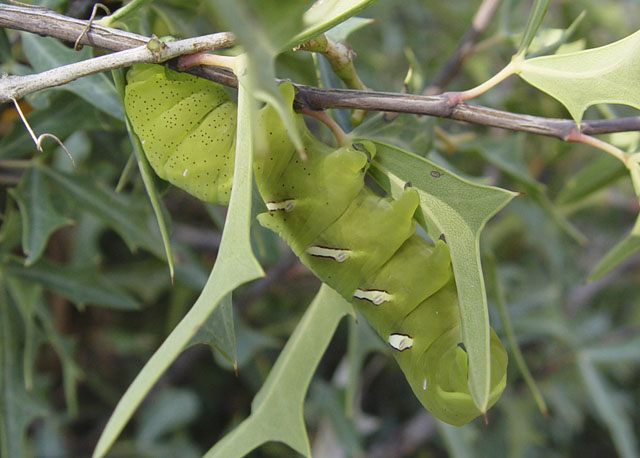
Eumorpha vitis, Austin, Texas, September 19, 2005, courtesy of Melody Lytle.
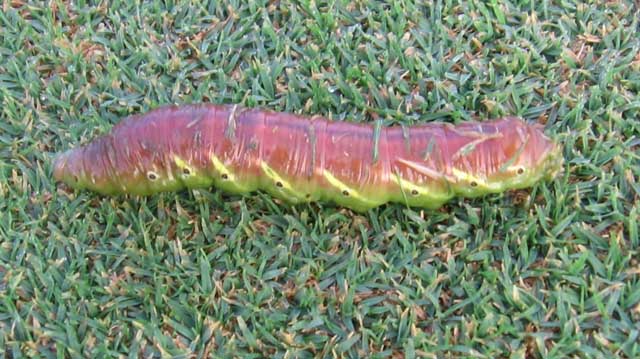
Eumorpha fasciatus, Austin, Texas, Kizer Golf Course,
November 2, 2005,
courtesy of
Scott Young via Mike Quinn.
Many of the Sphingidae larvae are highly variable within the species. Most darken considerably just before pupation, especially before the onset of cooler weather.
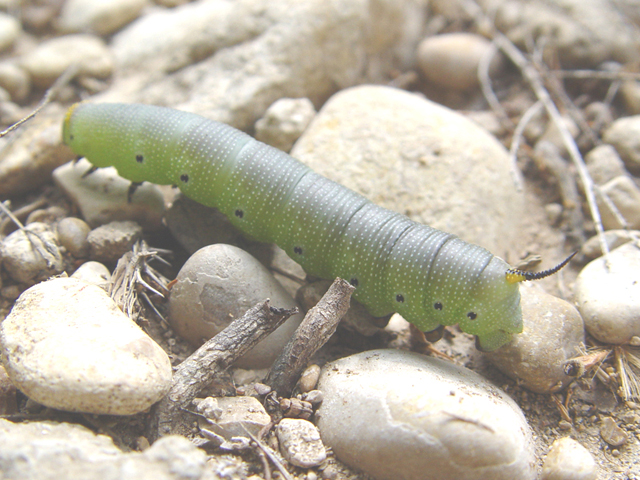
Hemaris diffinis, April 20, 2006 in the Barton Springs greenbelt, Austin
(Travis County),
courtesy of Melody Lytle.
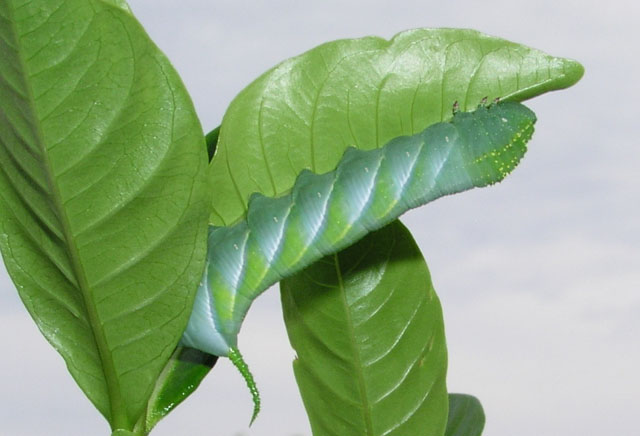
Manduca rustica, Austin, Texas, June 24, 2006, courtesy of Chandra Volkmar.
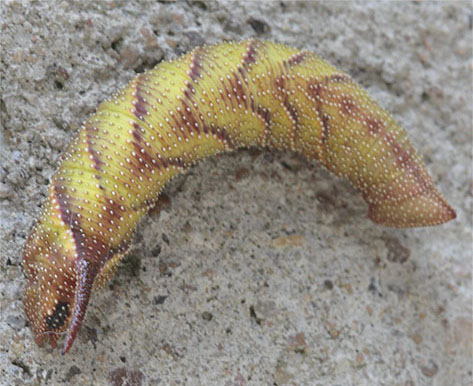
Amorpha juglandis, Austin, Texas, October 31, 2006, courtesy of Jill Posey.
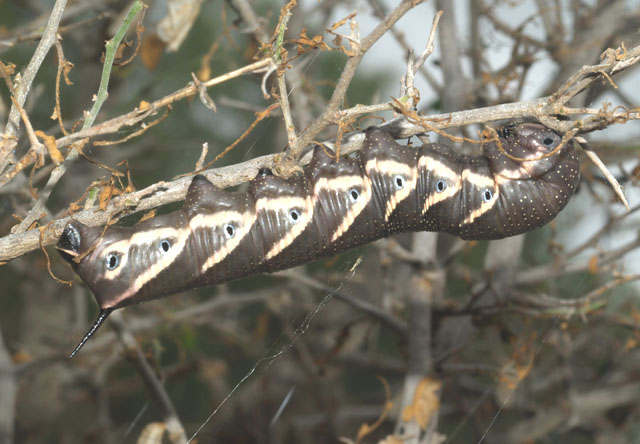
Manduca quinquemaculata San Antonio, Texas, courtesy of Larry Gilbert via Mike Quinn
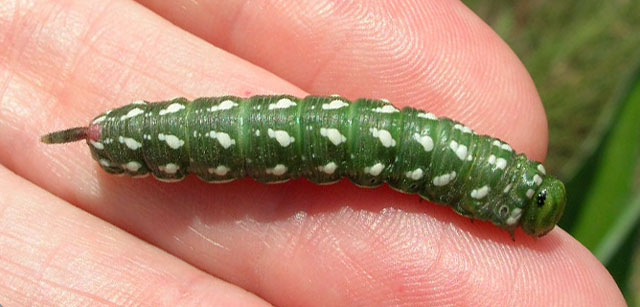
Sphinx dollii, just north of Austin, Texas, courtesy of David T. Anderson.
David's image of the Sphinx dollii larva gives a nice perspective on the size of this small Sphinx. The caterpillar had probably left nearby foliage in search of some soft earth in which to pupate.
Use your browser "Back" button to return to the previous page.
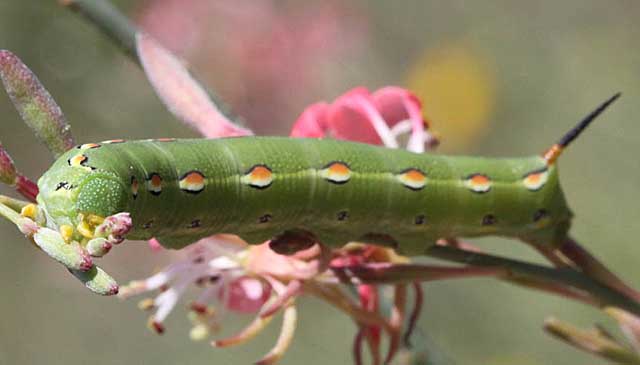
Hyles lineata fifth instar, Burnet County, Texas, May 19, 2009,
The host plant is Gaura, probably Gaura calcicola, courtesy of Steve Schwartzman.
Enjoy some of nature's wonderments, giant silk moth cocoons. These cocoons are for sale winter and fall. Beautiful Saturniidae moths will emerge the following spring and summer. Read Actias luna rearing article. Additional online help available.
Use your browser "Back" button to return to the previous page.
This page is brought to you by Bill Oehlke and the WLSS. Pages are on space rented from Bizland. If you would like to become a "Patron of the Sphingidae Site", contact Bill.
Please send sightings/images to Bill. I will do my best to respond to requests for identification help.
 Show appreciation for this site by clicking on flashing butterfly to the left. The link will take you to a page with links to many insect sites. |
I very much appreciate all the many images that have been sent to me, or of which I have been granted permission to copy and post from other websites. All images on this site remain the property of respective photographers.
If you would like to contribute to the maintenace of this website by sending a contribution to
Bill Oehlke
Box 476
155 Peardon Road
Montague, Prince Edward Island, C0A1R0
Canada
your donation would be much appreciated and would be used for
1) paying for webspace rental;
2) paying for computer maintenance and software upgrades;
3) purchases of additional text reference material (journals and books) in anticipation of expanding the site to a worldwide Sphingidae site;
4) helping to pay my daughter's tuition (completed spring 2013); with anything left over going to humanitarian aid.
If you are mailing a check from USA, please use $1.10 postage (2013 rate). Donations can also be made through Paypal via the button below.